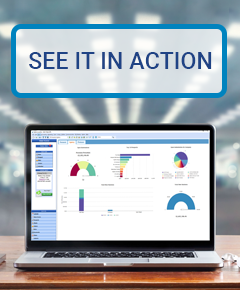
Agency Operations, Technology Trends
What makes quality customer service? Really, it’s not for you to say – it’s for your customers to define. Your customers have grown used to certain levels of service, and those expectations affect what they look for in their insurance agency support. And they’ll leave if they don’t see it.
“The way we’ve always done it” doesn’t work anymore. Legacy systems, siloed departments, and years-old processes lead to slow service and irritated customers. In a recent survey, more than 60% of P&C insurers revealed they still relied on these old processes and systems. Outdated technology leads to inefficient processes, which translate to lousy service.
How can your agency avoid falling into this service slow-down trap?
Know What Customers Want
Step one to meeting customer expectations is knowing what they want. According to our research, insurance customers look for:
- Mobile website access: A 2016 Accenture study showed 41% of respondents used a mobile device to make their insurance purchase – a number that is likely much higher now.
- Online portals: A recent Microsoft survey found 90% of respondents expected their provider to have an online portal and mobile access to it.
- Mobile app: A D. Power and Associates study found 74% of agencies surveyed offer an app for customers to manage policies and process claims via mobile.
- AI insights: An Accenture study found almost three-quarters of customers are “very or somewhat willing” to get insurance advice and answers from a computer-generated platform.
- Results from shared data: The same Accenture survey revealed 57% of respondents recognize the importance of sharing their data with insurers and are willing to do so in exchange for “added benefits” like personalized offers and discounts.
- Single point contact: Your customers value speed, but they also value consistency. A McKinsey survey showed when agencies moved customers to have a single point of contact, satisfaction increased by 50% and follow-ups decreased by more than 80%.
Discover the key to high customer satisfaction on our blog
Decide What Tech is Worth the Investment
There are dozens of tech solutions out there to meet the above customer needs, but that doesn’t mean they are all right for your agency. Start by deciding what tools you need (i.e., customer portal, CRM, marketing automation) and then look at specific systems. When looking, be sure to:
- Check with your management system user group to get advice and hear experiences
- Ensure new tools are compatible with your current systems
- Asses time savings and efficiency improvements as well as cost savings
- Ask about training and support provided
- Go for tools and systems with dynamic updates so you don’t need to buy the latest version year after year
Gain more insights on choosing the right tech for your agency here
Get All Your Insurance Support Needs in One Place
If you need a mobile app, we got that. Want a customer portal? We got that, too. CRM? Marketing automation? Mobile website templates? Yes, yes, and yes.
You can get all the insurance customer support tech you want, and the superior service you need to back it up, with the Partner Platform from SIS. With your management system, marketing, sales outreach, and customer support all in one pace, Partner Platform provides the unifying communications required to meet customer needs.
With Partner Platform, you’ll also get our new Partner Connect customer communication tool. Partner Connect ensures customers are being heard and supplied with the tools they want to connect with you.
Find out more about this innovative insurance customer support tool and the team behind it. Contact us at 800.747.7005, Option 6 or [email protected].

Marketing, Sales
It doesn’t matter whether you consider yourself introverted or extroverted; the fact is part of running an agency means meeting people and making connections. Everyone has their own way, but being social is a critical piece of your insurance agency marketing. Here are three ways you can up your interactions, engagements, and ultimately sales.
Discover more ways to reach out and make connections with our post on “How Do Insurance Agents Get Clients?”
- Go where the people are
Never expect people to come to you – it is always your job to go to them. That means getting “out there” physically and virtually.
Engage with prospects virtually with a social media presence. Create and maintain profiles on Twitter, Facebook, LinkedIn, and Instagram, among other platforms. Use these profiles to build relationships by interacting with followers and establishing your agency as a local expert.
Engage in social media groups, especially on LinkedIn, and use your profiles to watch for life changes from certain prospects. A Facebook post on getting a new car or tweet about a child graduating give signals it may be time for them to re-think their coverage.
Use the right outreach methods for your audience – find out how in our Marketing to the Generations post
You also need to be physically present in your target territories. Spend time in local coffee shops, attend services at a community church, and have your car serviced at an area auto body shop. Each time you’re out and about is an opportunity to see a prospect or current customer and build a relationship through conversation.
Go one step further by volunteering with local service agencies and attending local events like sports games or festivals. Get your name out there by sponsoring events or hosting booths, helping people to connect your agency with community and service. Hold events of your own as well, sharing your expertise in areas like planning for the future and protecting your home from natural disaster.
Read more on prospecting in your community in our recent blog post
- Keep them talking
When you do get into a conversation (whether online or in-person) keep your goal in mind. That goal may be to introduce yourself as an agent or to find out more about their needs, but ultimately it will always be to keep your conversation going. That means determining a time when you can talk again; setting up a meeting or phone call. Whatever you can do to move a step forward is a win.
In your impromptu conversations, focus on getting to know the person and find out what they’re looking forward to, worried about, or other significant events in their life. This creates an opportunity to think about how you can protect the things they need protected and bring peace of mind to them and their families. Use this knowledge when you meet.
During your planned meetings, find out what prompted them to meet with you and/or what they hope to get out of the meeting. With the right questions, you can uncover their direct needs, making it easier to win them as a customer. At the end of your meeting, ask if there is anything you missed that could help them commit.
Are you asking the right questions? Find out in our blog on Prospecting Right
- Use the right tools
Talking and engaging with prospects is only one part of the equation. You need the right tools to document and help you continue the conversations. Texting is becoming more popular for agents and customers alike, and integrated texting can help you capture these conversations instantly.
Marketing automation is another essential piece for prospecting. Segment your client and prospect lists to communicate the right message at the right time, and more easily stay in touch using automated campaigns.
How do you manage relationships with people who are not yet your customers? All the data you collect should be stored in a Customer Relationship Management (CRM) tool to help you manage activity and analyze your efforts.
The final pieces you need for quality outreach and engagement are a branded app, client portal, and high-quality website. Each of these elements is essential to your online presence and customer service.
The app and portal allow customers and prospects to reach you wherever you are and get the information they need instantly.
Your website is your landing place – it’s where people will go after they’ve talked with you or to do research before a meeting. Make sure it is well-branded, easy to navigate, and an effective way for customers to connect with you.
See why your website is the key to cracking the insurance sales code
Effectively Engage with Partner Platform
Once you have new leads, you need to track, engage, and nurture each before they become customers. We’ve designed our Partner Platform agency management tool to do just that. Partner Platform offers an integrated Producer Results Manager CRM to follow prospect progress, and Marketing Automation Manager to keep contacts connected. And, we’re introducing our Partner Connect customer engagement tool to keep prospects-turned-customers engaged for years to come.
Find out more about Partner Platform and how it can help you get connected, stay engaged, and boost sales: contact us at 800.747.7005, Option 6 or [email protected].

Marketing, Sales
As an independent insurance agency, you have a significant advantage over the industry goliaths: community connections. No matter how hard they try, large insurance corporations cannot be part of a local community. You, however, have been a part of your community for decades – but are you a part of its fabric? Are you leveraging your community connection for insurance prospecting?
Leveraging Community Connections for Insurance Prospecting
There are a few ways you can get yourself known and capitalize on your place as an agent in your local community. A few examples include:
- Pledge sponsorship. Get your name out there by supporting a local sports team, charity event, or organization. Sponsorship literally gets your name out there on event signs or team jerseys, and it also shows you have a heart for helping others. That connection resonates with potential customers who will see you as a concerned and caring advocate they can trust.
See more tips on how to engage in your local community on our blog
- Share your expertise. Hold events at your offices to share free advice. Establish a social presence and comment on local happenings, sharing your thoughts on how to stay safe. Use these and other tactics to establish yourself as an expert and an organization that cares.
- Stay seen. Be physically present around your community. Go to local coffee shops, bank in your community, go to church there, and say hello to customers and prospects around town. Don’t make all your conversations about business. Ask about their lives, catching up on happenings in their family and the community, to foster your relationship and show you care about them beyond their premium.
- Get involved. Attend local events and festivals, whether as a participant or a volunteer. Showing your face at these happenings sends the message that community is important to you and your agency.
Get your agency involved and invested by joining industry groups like these
- Ask for referrals. Though you don’t want all your conversations to be about business, at some point you do have to ask for referrals. You have a strong network to tap into in your community. When you’re talking with a happy customer, ask if they have friends or family that are in need, too.
What Community Means to SIS
Community is what we’re built upon here at SIS. Our Partner Platform agency management system is shaped, tested, and constantly improved by our community of independent agencies. We couldn’t be who we are without their influence and support.
See what it means to be an SIS partner agency by reading our client stories. Or, check out our post on what service means to us and our independent agencies.
Learn more about our Partner Platform community on partneragents.com.

Technology Trends
As a small business with tight margins, independent insurance agents are smart to be wary of insurance software trends. New software requires investment – of both money and time – and agency owners want to be sure these investments pay off.
We’ve got our ear to the ground when it comes to agency “here and gone” versus “here to stay” trends. These are six trends-turned traits to add to your agency ASAP.
- Self-Service Portals
With the ability to offer electronic payments, printable ID cards, and contact information updates, a self-service portal is a must in the digital age. Customers will expect you to have an agency-branded portal to help them take care of business immediately, day or night, without waiting on your agency to take action.
- Mobile Apps (for you and your customers)
A recent Agency Revolution poll showed 84% of customers said they don’t want a phone call from their agent with questions – they want an app to connect. You need an outward facing app for your customers to upload claim information and get the answers they need on the go. The same is true for your agents. An app synced with your agency management system provides instant access to critical information while they’re out in the field.
- eSignature Integration
As printers become more scarce, esigning is becoming more popular. Your agency should have esignature integration built into your policy process to speed up purchase and quicken claims resolution, among other actions. And, esignatures provide an added level of security in an age where cyber threats loom.
Read more on data security and your agency on the SIS blog
- Integrated CRM
An integrated Customer Relationship Manager (CRM) provides your agents the organization they need for better prospecting. With an integrated CRM, you can leverage your agency management system constituents for cross-selling, referrals, and more. Set up outreach campaigns for audience groups and create targeted messaging to increase your reach and response.
- Marketing Automation
Integrated marketing automation helps you stay on top of connecting with customers and prospects in an era where the onus for outreach is on you. Set up pre-generated emails to welcome customers, remind on renewals, and celebrate special occasions (i.e., birthdays, holidays). Automation helps you keep up regular engagement to welcome new leads, nurture current prospects, and retain customers simultaneously.
Learn more about marketing automation and how it fosters omnichannel outreach here
An All-in-One Agency Management Software Solution
We’re up on insurance software trends here at SIS thanks to constant feedback from our partner agencies. Each and every Partner Platform update is informed by client needs and expert research. See the full list of Partner Platform capabilities here, and experience them in person when you request a demo today.

Agency Operations, Marketing, Sales
For most independent insurance agencies, superior customer service is their bread and butter. Beyond serving your local community and providing a quality service to those in need, good customer service is also tied to better business. One survey recently found over 80% of respondents would pay more for a better customer service experience. There is value in bettering your customers’ experience, and you already have the means in your agency workflows.
These five steps can help you gain insight into customer needs and put them into practice.
Step 1: Identify Interaction Points
Take a look at the where you interact with customers: online, over the phone, in person – all of these are opportunities to gain information on what your customers want and care about. Once you know what matters to them, you can start putting them into practice in these existing interactions.
Get more insights on how to improve customer relationships on our blog
Step 2: Document Customer Interactions
Once you know where you’re interacting with customers, come up with a method to document each encounter. The more in-depth info you collect, the better. Management system mobile apps come in handy here as they allow agents to immediately document meetings and their details. Email and texting integration are also beneficial as each instantly captures an entire exchange and syncs to the customer’s record.
Step 3: Determine Where Interaction Documentation Lives
Once you have a way to record information on customer interactions, you need to have a place to put that information. Too often, agents and CSRs are keeping customer interaction data in siloed spaces. You need to find a spot to bring it all together. Ideally, your agency management system is built to address the needs of your service and sales teams.
Step 4: Establish Process to Follow Up on Interactions
Tracking customer interactions is only a piece of what you’re trying to accomplish. To truly improve these interactions, you need to follow up on conversations. In most cases, follow up comes from a CSR providing service to conclude a suspense, but not all conversations have such defined follow-up needs. Some interactions need a simple check-in to see how things are going and to get a feel of whether a customer was satisfied with the service they received. This can be via automated or manual methods or a combination of both.
Never forget to follow up – get reminders through Partner Platform’s Marketing Automation Manager
Step 5: Ensure You Have the Right Tools to Get the Job Done
For any customer interaction to happen, you need to provide ways for customers to connect with your agency. The essential customer connection tools are 1) an easy to use and understand website, 2) customer-facing mobile app, and 3) branded client portal. Each of these tools face out to the customer and give them an opportunity to connect with you.
We’ve brought all three together in our latest Partner Platform addition, Partner Connect. Partner Connect is a multi-faced customer experience for users to enhance customer communication with agency-branded tools. With multiple offer levels to fit your agency, Partner Connect provides all the tools you need at the right price.
Find out more about Partner Connect and the Partner Platform agency management system – contact us at [email protected] or 800.747.7005, Option 6.
Page 18 of 34« First«...10...1617181920...30...»Last »






